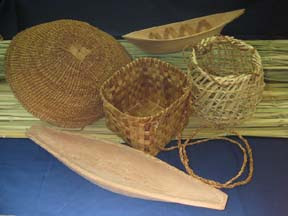Knowledge about the pre-history of South King County is often limited and based on misconceptions. Changes in the way schools interact with the Renton History Museum provided us the stimulus to find new ways to reach out to students to teach them about the Native American ancestors of our region.
Until 2006 the Museum had the opportunity to educate kids about Coast Salish culture, which includes the local Duwamish people, during annual third grade field trips organized by the Renton School District. Unfortunately, the economic downturn made it impossible for the School District to continue these trips. Hoping to develop a substitute for this experience, the Museum’s Education Department applied to 4Culture and Sam’s Club for grants to design a Coast Salish/Duwamish Curriculum we could bring to classrooms. We recruited a team of specialists with backgrounds in education and Native American studies, and spent nine months working on a multi-phase program. By spring 2009 we were ready to test the curriculum with fourth grade students.
The curriculum consists of a lesson plan to guide teachers and a Cultural Education Kit including replicas of Coast Salish objects and sets of primary and secondary sources.

The curriculum’s main objective is to have students answer the essential question “How did the environment shape the economic, social, and spiritual lives of the Coast Salish/Duwamish Peoples before the arrival of Europeans?” by working through five classroom units. The curriculum fulfills requirements for Classroom-Based Assessments (CBAs), Essential Academic Learning Requirements (EALRs), and Grade Level Expectations (GLEs) in Visual Arts, standards set by of the Office of the Superintendent of Public Instruction (OSPI).
In the first three units, groups of students analyze objects—cedar canoes, baskets, hat, rope, and a cattail mat—present their findings, and participate in a slide presentation exploring Coast Salish culture. Units Four and Five give them an opportunity to exercise their creativity as they make paper replicas of the objects they have analyzed.

Students also listen to Coast Salish stories on CD. Together the units immerse kids in Coast Salish culture and stress the ways in which the natural environment shaped the lives of Native Peoples. Museum docents work very hard to ensure students leave with a basic knowledge of the Coast Salish’s most important resources: cedar trees, rivers, and salmon, which were found in abundance in Puget Sound region more than 100 years ago.
To date the curriculum has been implemented at five elementary schools with positive feedback from teachers. The Coast Salish Curriculum is offered free of charge to Renton public elementary schools. Private schools and schools in other districts can rent the Cultural Education Kit for a fee. The curriculum will be available in the fall at www.rentonhistorymuseum.org. Teachers can also contact the museum directly at 425-255-2330 or email drahn@rentonwa.gov.
Dorota Rahn is the Volunteer and Education Coordinator for the Renton History Museum.
